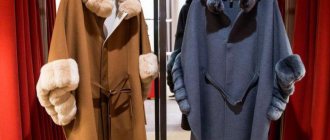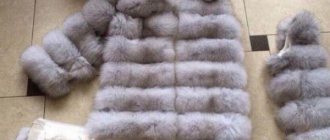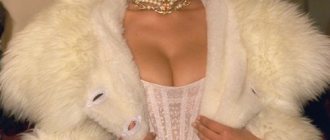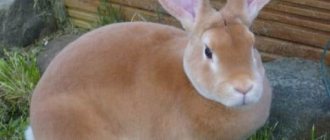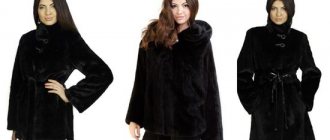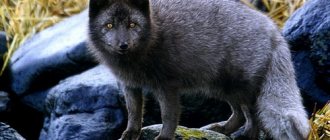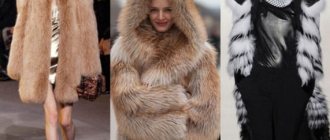At all times, fur was considered a sign of luxury and wealth. Today, when in addition to a fur coat you can warm yourself with other warm things, furs have definitely become an item of status. Many women and their wealthy companions are ready to shell out thousands of dollars for luxurious products, and the richest and most famous people also have wonderful collections. Therefore, despite the popularity of animal welfare movements and the popularization of artificial fur, natural fur coats will never go out of fashion and will never cease to be desirable objects of luxury and comfort.
How to determine which fur for a fur coat is the most expensive
Any type of fur has its own specific value, and each of them can cost differently. Much depends on the habitat of the animal, the color and dressing of the skin. At special auctions, fur factories trade for them in order to then sew the most expensive and beautiful products from the purchased fur. Depending on the attractiveness of the skins, the price of a fur coat can vary between hundreds and even thousands of dollars.
However, there are certain rules by which it is estimated which are the most expensive furs for a fur coat. The rating of materials is based on the following factors:
- rarity of the animal;
- fur color;
- method of processing the skin;
- prestige of the fur brand;
- fashion.
For example, some animals were once so popular that poaching reduced or even practically destroyed their population. Therefore, no one knows which fur coat may become the most expensive tomorrow, and from what fur. The price of finished outerwear may also depend on the size of the animal. For example, chinchilla skins are very small. Therefore, more than one animal will be required for one fur coat, which means the price of the finished product will be high. As for color, in some furs it plays an important role. This is, for example, a mink. White and black are valued much higher than brown.
And, of course, fashion plays an important role in what the most expensive fur coat will be, what fur it will be made of and why. If tomorrow fox products become the most sought-after items from a designer's point of view, it will not be surprising that outerwear made from fox will become more expensive than they were before.
Sable
Fur gold, the king of furs and many other epithets have sable fur. Its only supplier worldwide is Russia. Here, from time immemorial, it was the most expensive fur for a fur coat. Our country is home to several groups of sables that are used for industry. They all differ in color, thickness, splendor and length.
In addition, sable sheds and changes the structure and color of its fur. Therefore, animal skins are collected twice a year in different seasons. Thus, obtaining different colors and quality of fur. In winter, the first grade skins are removed, when the fur is especially shiny and soft. At this time of year the animal has a lot of downy hair. That's why its fur is fluffier. In late winter, the hair becomes dull and the skins obtained during this period are duller. This affects the appearance of the finished products. At the beginning of winter, after the sable has shed most of its fur in the summer, the skin is only second grade.
Asher cat, up to $25,000
This cat breed was introduced in 2007. She was named after the goddess Asherah. This is one of the largest domestic cats and can grow up to 1 m in length and weigh up to 14 kg.
Then it was stated that it was a cross between an African serval, a Bengal and a domestic cat. But a DNA test showed that the Asher cat is a representative of the Savannah breed, which was bred in the early 1980s. The “Savannah” breed was obtained after crossing an African serval and a Bengal cat, and the latter was a hybrid of a domestic and wild Bengal “Murka”.
The scammers tried to present the animal as a new breed and they succeeded; the kittens were sold for huge sums of money. But the Savannah breeder recognized his pet and exposed the deceivers.
Barguzin sable
It is worth mentioning separately about this type of sable, the Barguzinsky. After all, this is perhaps the most expensive fur for a fur coat. The price of its skin can exceed $1,000. And considering that you need about 90 of them for a fur coat, it becomes clear that such a fur coat will be worth its weight in gold. This species of sable lives only in Russia, namely in the eastern part of Lake Baikal.
What makes the most expensive fur coat in the world especially valuable is its shade – dark brown, almost black, with many silvery hairs that give the finished fur coat shine and depth. In addition to color, Barguzin sable has increased wear resistance and high thermal qualities.
Chinchilla
This animal lives in South America, and its skins are valued for their incredible beauty. Its fur has different shades - on the back it is dark gray, on the sides it is smoky blue, and on the belly it is snow-white. This effect is preserved in the finished product, where the smooth transition of shades looks very beautiful.
This fur is also distinguished by the fact that it is very thick, due to the fact that up to 70-80 hairs can grow from one hair follicle in this animal. Their length is about 3 centimeters. Therefore, chinchilla fur is more like down. This is what provides him with special warmth and softness. This is why chinchilla fur coats are so valued.
The only disadvantage of such skins is that the fur is not very durable and quickly loses its original appearance. Therefore, such a fur coat is bought exclusively for rare ceremonial appearances. In addition, skins are used in combination with other fur. But, despite this drawback, this is one of the most expensive furs for a fur coat - it can cost from 10 to 100 thousand dollars.
Strange and rare animals (61 photos)
In this post there will be scary, nasty, cute, kind, beautiful, incomprehensible animals. Plus a short comment about each. They all really exist. Watch and be surprised.
The slittooth
is a mammal from the order of insectivores, divided into two main species: the Cuban slittooth and the Haitian. The animal is relatively large compared to other types of insectivores: its length is 32 centimeters, its tail is on average 25 cm, the weight of the animal is about 1 kilogram, and its body is dense.
MANED WOLF
. Lives in South America. The long legs of the wolf are the result of evolution in matters of adaptation to the habitat; they help the animal to overcome obstacles in the form of tall grass growing on the plains.
The AFRICAN CIVET
is the only representative of the genus of the same name. These animals live in Africa in open spaces with high grass from Senegal to Somalia, southern Namibia and in the eastern regions of South Africa. The size of the animal can visually increase quite significantly when the civet raises its fur when excited. And her fur is thick and long, especially on the back closer to the tail. The paws, muzzle and tail end are completely black, most of the body is spotted.
MUSHROOM
. The animal is quite famous due to its sonorous name. It's just a good photo.
PROHIDNA
. This miracle of nature usually weighs up to 10 kg, although larger specimens have also been observed. By the way, the length of the echidna’s body reaches 77 cm, and this is not counting their cute five to seven centimeter tail. Any description of this animal is based on comparison with the echidna: the legs of the echidna are higher, the claws are more powerful. Another feature of the echidna’s appearance is the spurs on the hind legs of males and the five-fingered hind limbs and three-fingered forelimbs.
CAPIBARA
. Semi-aquatic mammal, the largest of modern rodents. It is the only representative of the capybara family (Hydrochoeridae). There is a dwarf variety, Hydrochoerus isthmius, which is sometimes considered as a separate species (lesser capybara).
SEA CUCUMBER.
HOLOTHURIA . Sea capsules, sea cucumbers (Holothuroidea), a class of invertebrate animals such as echinoderms. Species eaten as food are commonly known as sea cucumbers.
PANGOLIN
. This post simply could not do without him.
HELL VAMPIRE
. Mollusk. Despite its obvious similarity with octopus and squid, scientists have identified this mollusk as a separate order Vampyromorphida (lat.), because it is characterized by retractable sensitive whip-shaped filaments.
AARDEAKER
. In Africa, these mammals are called aardvark, which translated into Russian means “earthen pig.” In fact, the aardvark is very similar in appearance to a pig, only with an elongated snout. The structure of the ears of this amazing animal is very similar to that of a hare. There is also a muscular tail, which is very similar to the tail of an animal such as a kangaroo.
JAPANESE GIANT SALAMANDER
. Today it is the largest amphibian, which can reach 160 cm in length, weigh up to 180 kg and can live up to 150 years, although the officially recorded maximum age of the giant salamander is 55 years.
BEARDED PIG
. In different sources, the Bearded Pig species is divided into two or three subspecies. These are the curly bearded pig (Sus barbatus oi), which lives on the Malay Peninsula and the island of Sumatra, the Bornean bearded pig (Sus barbatus barbatus) and the Palawan bearded pig, which live, as the name suggests, on the islands of Borneo and Palawan, as well as on Java , Kalimantan and small islands of the Indonesian archipelago in Southeast Asia.
SUMATRAN RHINOS
. They belong to the odd-toed ungulates of the rhinoceros family. This type of rhinoceros is the smallest of the entire family. The body length of an adult Sumatran rhinoceros can reach 200–280 cm, and the height at the withers can vary from 100 to 150 cm. Such rhinoceroses can weigh up to 1000 kg.
SULAWESI BEAR COUSCUS
. An arboreal marsupial living in the upper layer of lowland tropical forests. The fur of the bear cuscus consists of a soft undercoat and coarse guard hairs. Coloration ranges from gray to brown, with a lighter belly and limbs, and varies depending on the geographic subspecies and age of the animal. The prehensile, non-haired tail is approximately half the length of the animal and serves as a fifth limb, making it easier to move through the dense tropical forest. The bear cuscus is the most primitive of all cuscus, retaining primitive tooth growth and structural features of the skull.
GALAGO
. Its large fluffy tail is clearly comparable to that of a squirrel. And his charming face and graceful movements, flexibility and insinuation, clearly reflect his cat-like traits. The amazing jumping ability, mobility, strength and incredible dexterity of this animal clearly show its nature as a funny cat and an elusive squirrel. Of course, there would be a place to use your talents, because a cramped cage is very poorly suited for this. But, if you give this animal a little freedom and sometimes allow him to walk around the apartment, then all his quirks and talents will come true. Many even compare it to a kangaroo.
WOMBAT
. Without a photograph of a wombat, it is generally impossible to talk about strange and rare animals.
AMAZONIAN DOLPHIN
. It is the largest river dolphin. Inia geoffrensis, as scientists call it, reaches 2.5 meters in length and weighs 2 quintals. Light gray juveniles become lighter with age. The Amazon dolphin has a full body, with a thin tail and a narrow muzzle. A round forehead, a slightly curved beak and small eyes are the characteristics of this species of dolphin. The Amazonian dolphin is found in the rivers and lakes of Latin America.
MOONFISH or MOLA-MOLA
. This fish can be more than three meters long and weigh about one and a half tons. The largest specimen of the sunfish was caught in New Hampshire, USA. Its length was five and a half meters, there is no data on weight. The shape of the fish’s body resembles a disk; it was this feature that gave rise to the Latin name. The moon fish has thick skin. It is elastic, and its surface is covered with small bony projections. The larvae of fish of this species and young individuals swim in the usual way. Adult large fish swim on their sides, quietly moving their fins. They seem to lie on the surface of the water, where they are very easy to spot and catch. However, many experts believe that only sick fish swim this way. As an argument, they cite the fact that the stomach of fish caught on the surface is usually empty.
TASMANIAN DEVIL
. Being the largest of modern predatory marsupials, this black animal with white spots on the chest and rump, with a huge mouth and sharp teeth has a dense physique and a stern disposition, for which, in fact, it was called the devil. Emitting ominous screams at night, the massive and clumsy Tasmanian devil looks like a small bear: the front legs are slightly longer than the hind legs, the head is large, and the muzzle is blunt.
LORI
. A characteristic feature of the loris is its large eyes, which can be bordered by dark circles; there is a white dividing stripe between the eyes. The face of a loris can be compared to a clown mask. This most likely explains the animal's name: Loeris means "clown".
GAVIAL
. Of course, one of the representatives of the crocodile order. With age, the gharial's muzzle becomes even narrower and longer. Due to the fact that the gharial feeds on fish, its teeth are long and sharp, located at a slight angle for ease of eating.
OKAPI.
FOREST GIRAFFE . Traveling through Central Africa, journalist and African explorer Henry Morton Stanley (1841-1904) more than once encountered local aborigines. Having once met an expedition equipped with horses, the natives of the Congo told the famous traveler that in their jungle there were wild animals very similar to his horses. The Englishman, who had seen a lot, was somewhat puzzled by this fact. After some negotiations in 1900, the British were finally able to purchase parts of the skin of the mysterious animal from the local population and send them to the Royal Zoological Society in London, where the unknown animal was given the name “Johnston's Horse” (Equus johnstoni), that is, it was assigned to the equine family . But imagine their surprise when a year later they managed to get a whole skin and two skulls of an unknown animal, and discovered that It looked more like a dwarf giraffe from the Ice Age. Only in 1909 was it possible to catch a living specimen of Okapi.
WALABI.
TREE KANGAROO . The genus of Tree kangaroos - wallabies (Dendrolagus) includes 6 species. Of these, D. Inustus or the bear wallaby, D. Matschiei or Matchisha's wallaby, which has a subspecies D. Goodfellowi (Goodfellow's wallaby), D. Dorianus - the Doria wallaby, live in New Guinea. In Australian Queensland, there are D. Lumholtzi - Lumholtz's wallaby (bungari), D. Bennettianus - Bennett's wallaby, or tharibin. Their original habitat was New Guinea, but now wallabies are also found in Australia. Tree kangaroos live in tropical forests of mountainous regions, at altitudes from 450 to 3000m. above sea level. The body size of the animal is 52-81 cm, the tail is from 42 to 93 cm long. Wallabies weigh, depending on the species, from 7.7 to 10 kg for males and from 6.7 to 8.9 kg. females.
WOLVERINE
. Moves quickly and deftly. The animal has an elongated muzzle, a large head, with rounded ears. The jaws are powerful, the teeth are sharp. Wolverine is a “big-footed” animal; its feet are disproportionate to the body, but their size allows them to move freely through deep snow cover. Each paw has huge and curved claws. Wolverine is an excellent tree climber and has keen eyesight. The voice is like a fox.
FOSSA
. The island of Madagascar has preserved animals that are not found not only in Africa itself, but also in the rest of the world. One of the rarest animals is the Fossa - the only representative of the genus Cryptoprocta and the largest predatory mammal living on the island of Madagascar. The appearance of the Fossa is a little unusual: it is a cross between a civet and a small puma. Sometimes the fossa is also called the Madagascar lion, since the ancestors of this animal were much larger and reached the size of a lion. Fossa has a squat, massive and slightly elongated body, the length of which can reach up to 80 cm (on average it is 65-70 cm). The fossa's paws are long, but quite thick, with the hind paws being higher than the front paws. The tail is often equal to the length of the body and reaches up to 65 cm.
MANUL
approves of this post and is here only because he must be present. Everyone already knows him.
PHENEC.
STEPPE FOX . He assents to the manula and is present here insofar as. After all, everyone saw him.
THE NAKED NARROW
gives the Pallas's cat and the fennec cat a plus in their karma and invites them to organize a club of the most fearful animals on the RuNet.
PALM THIEF
. Representative of decapod crustaceans. Its habitat is the western Pacific Ocean and the tropical islands of the Indian Ocean. This animal from the family of land crayfish is quite large for its species. The body of an adult reaches a size of up to 32 cm and a weight of up to 3-4 kg. For a long time it was mistakenly believed that with its claws it could even crack coconuts, which it then eats. To date, scientists have proven that crayfish can only feed on already split coconuts. They, being its main source of nutrition, gave the name palm thief. Although he is not averse to eating other types of food - the fruits of Pandanus plants, organic substances from the soil, and even his own kind.
The name of this fish in Latin sounds too boring, so it’s easier to call it
FISH WITH A TRANSPARENT HEAD
. She has a transparent head through which she can see with her tubular eyes. The head, through which the fish watches for prey, helps protect the eyes. First opened in 1939. It lives at a much greater depth, so it has not been fully studied. In particular, the principle of fish vision was not entirely clear. She was supposed to have great difficulty due to the fact that she could only look up. Only in 2009 was the structure of the eye of this fish fully studied. Apparently, when trying to study it earlier, the fish simply could not tolerate the change in pressure.
ECHIDNA
. Well, that's all.
LESS RED PANDA
. Today, the red panda in its natural habitat can only be found in the mountain bamboo forests of the Chinese provinces of Yunnan and Sichuan, in northern Burma, Bhutan, Nepal and northeast India.
SIFAKA
. Monkey of the Indriidae family. A relatively new genus of primates, discovered only in 2004. Silky sifakas live in the eastern part of the island of Madagascar. The area is approximately 2.2 thousand square meters. km. The distribution area is limited in the north of the island to the Marojejy Massif region, and in the south it reaches Anjanahari. Adult individuals have a body length with a head from 45 to 55 cm, a tail 45-51 cm long. Weight is 5-6.5 kg.
SLOTH
. A very interesting species of mammals, possessing a number of distinctive features that make it unlike any other existing species. It lives mainly in Central and South America.
platypus
. In principle, everyone knows it. But this photo deserves attention...
ANTEATER
. It won't surprise anyone either. But the shot is great...
tarsier
. A small mammal from the order of primates, the very specific appearance of which created a somewhat ominous aura around this small animal weighing up to one hundred and sixty grams. Thus, the indigenous population of Indonesia and the Philippine Islands associated the absurd appearance of the tarsier with the tricks of evil spirits. However, many of our contemporaries, who see the tarsier for the first time in its native habitat, remain amazed by its non-standard appearance.
MARGAY
. These wild cats are distinguished from their “relatives” by their body size and proportions, as well as their lifestyle. For example, the margay is very similar to its closest relative, the ocelot, which, moreover, is quite often found in the same place where the margay lives. It is not difficult to distinguish these cats - the ocelot is noticeably larger, since it prefers to hunt on the ground, and the margay has longer legs and tail, due to life mainly in trees.
MUD JUMPER
. Found in intertidal areas and in areas such as tropical swamps formed by mangrove trees. Mudskippers especially love to settle in places where fresh water meets sea water. And although from a scientific point of view they are fish, many perceive them as amphibians. Well, in a way it is.
HERBIVORE DRACULA
. Bats (“Sphaeronycteris toxophyllum” lat.) This species lives in the north of South America (Amazon River basin and mountains). These bats, oddly enough, are herbivores.
BELT-TAIL
. The habitat of belted tails extends to the rocky regions of Africa, which have an arid climate, mainly on the southern side of the Sahara Desert. In addition, belted tails live in certain numbers on the island of Madagascar. There are more than forty species of belttails in the world. The sizes of belt-tails vary quite widely and range from 12 to 70 centimeters in length. The entire body of the belt-tail is covered with rectangular plates - scales, which cover the bony base of the reptile.
In my opinion, a modest fellow.
LILE FROG
. Some animals have managed to adapt to these, at first glance, very difficult conditions and have even learned to benefit from the changing seasons. So the indigenous Indian purple frog (Nasikabatrachus sahyadrensis), which as a species was discovered quite recently - in 2003, uses the monsoon time to its advantage - to continue its kind.
ISOPOD
. Giant isopod woodlice, approximately 30 cm long, live at sea depths of about 1.6 km.
SUN BEAR
. The Malayan biruang bear, or, as it is also called due to its characteristic color, the sun or honey bear, lives in India, Myanmar, as well as on the islands of Borneo, Java and Sumatra. It is of quite great interest to both zoologists and wildlife lovers, since this species is one of the smallest, most aggressive and smallest representatives of the entire bear family. By the way, it was precisely the threatening small number of this genus that became the reason for the inclusion of biruangs in the Red Book. An adult sun bear has a very difficult character. However, quite a lot of interest in his person is caused not at all by his habitat, and not by his character, but by his stunning appearance, which immediately catches the eye from any photograph.
TIBETAN FOX
. Found in Tibet, northwest India and northern Nepal at high altitudes.
MEDUSA
. Just a giant jellyfish.
GOLDEN TIGER
. This is what tigers with a similar color are called. The reason for the unusual color is that one of the genes did not work. Count like an albino...
AY-AY.
ARM POD . Madagascar monkey or aye-aye, a mammal of the suborder of prosimians; the only representative of the family of arms. Body length 40 cm, tail 60 cm. The head is large, the muzzle is short; The ears are large and leathery. The tail is fluffy. The coat color ranges from dark brown to black.
GUYDAK
. A large gastropod weighing up to one and a half kilograms. Found off the west coast of the USA. From under the thin fragile shell of the guidac (about 20 cm in length) protrudes a “leg” that is three times larger than the shell. The English name for this mollusk (geoduck, gweduck) appeared at the end of the 19th century, is derived from the name of these mollusks in the language of the Nisqual Indians (which is why it is pronounced “guiduck”) and means “deep-digging” - these mollusks really bury themselves quite deeply in the sand.
MARSPALY WOLF
.
It is an extinct marsupial mammal and the only representative of the thylacine family. This animal is also known as the “marsupial tiger” and “Tasmanian wolf”. At the beginning of the Holocene and the end of the Pleistocene, the marsupial wolf was found on the Australian mainland and the island of New Guinea. About 3,000 years ago, Aboriginal settlers brought the wild dog dingo to the island, as a result of which the marsupial wolf disappeared from the area. In the XVIII-XIX centuries. Tasmania was considered the main habitat of the marsupial wolf, but in the thirties of the 19th century, mass extermination of the animal began, which was mistakenly considered a destroyer of domestic sheep. In addition, the thylacine was credited with hunting poultry and exterminating game caught in traps. Most of these legends turned out to be untrue. LAMPRIPE
. A species under threat of extinction. Reaches a length of 120 cm and a weight of 3 kg. Spawns in June-early July in rivers. The male builds a nest with a diameter of about 50 cm and guards it. After spawning, the spawners die. The larvae live in the river for 5-6 years, after metamorphosis, the young lampreys slide into the sea, the sea period is about 3 years. In the sea they attach themselves to fish (external parasites of large fish) - cod, flounder, etc.
STARNISHER . An insectivorous mammal of the mole family. Externally, the starfish differs from other members of the family and from other small animals only in its characteristic stigma structure in the form of a rosette or star of 22 soft, fleshy, mobile bare rays. In size, spade-shaped forelimbs, thick velvety fur (black or dark brown) it is similar to the European mole.
Lynx
This animal from the cat family is distinguished by its beautiful coloring - who would not recognize the dark spots on the red background of the back or on the white fur in the abdomen. What are outerwear made from? To produce fur products, it is the light fur from the belly of the animal that is taken, as it is fluffier and softer. On the back it is hard, so it is not used in the manufacture of fur coats.
In Russia, the lynx is listed in the Red Book and is strictly protected. Therefore, only Canadian species are used for sewing fur coats. The cost of one skin can start from $300. Therefore, very often they are used not for sewing a whole fur coat, but for a collar or cuffs.
What parameters were taken into account during the assessment?
The cost of fur products, before they go to the salon and find their buyer, is estimated according to the following indicators:
- rarity of furs;
- wear resistance;
- thick pile;
- ability to retain heat;
- color saturation;
- skin density;
- pile length;
- natural shiny sheen;
- silkiness;
- unusual texture.
Fur coat sizes - how to determine yours?
What is a sheepskin coat
Ermine
This small animal lives only in Siberia, Canada and Lapland. During the season, the color of its skin changes, but it is valuable only in winter, when the animal’s fur is completely white.
Since ancient times, this has been one of the most expensive furs for fur coats and not only - ermine was used to decorate the robes and formal clothes of kings, kings and other royalty, sewed collars, lined cloaks with fur and made capes from it. And today this snow-white material is a privilege that is available to few. In addition, ermine fur is very capricious and almost as short-lived as chinchilla. Therefore, a fur coat made from it is an exclusively ceremonial version of outerwear. The price for the product can be 2-5 thousand dollars.
White Lion, $140,000
The unusual color is caused by a disease called leucism. Such cubs can be born to a cream lioness. The baby is not always born snow-white. But even in a black and white lion, the spots disappear over time. Zoos breed them.
The white lion can also appear in natural conditions. But it can be very difficult for such animals to survive, because... the unusual color gives away the predator and interferes with the hunt. Lion cubs become prey for hyenas. But the peoples of Africa revered these animals. It was believed that seeing a white lion could atone for sins, gain strength and become happy.
Vicuna
This animal is a type of llama and is found only in the high Andes regions of Peru. Due to its place of residence, where there are always strong winds, the fur of this animal is very dense and warm, but at the same time delicate and soft. It was because of these qualities that people loved him so much. All this led to the fact that the vicuña practically disappeared from the face of the earth. Therefore, in the 60s of the 20th century, only the shearing of the animal was legalized, but not its catching.
Today it is the most expensive fur for a fur coat in the world, even taking into account the fact that vicuña fur is not extracted in the classical way, by removing the skin from the animal, but is sheared and made into wool fabric with a price of 3 thousand dollars per meter. However, given the number of individuals remaining in the population, the fabric obtained in a year is only enough to sew 150 suits, and only a few of the most famous fashion houses are engaged in this. As for natural vicuña fur, and especially fur coats made from it, it is almost impossible to find such a surviving rarity in nature today.
Marten
The fur of this animal is very similar to the fur of a sable. However, it is less lush and much cheaper. Therefore, in Europe, where the sable is not found, and the marten, on the contrary, has habitats, it successfully replaces its more luxurious brother.
The color of marten fur can vary: from brown to blue-gray. But winter skins with the thickest undercoat and long hair have a special charm. This fur is very durable and warm, and thanks to this two-layer wool, the animal’s fur is well ventilated and does not retain dust. Therefore, it is considered hypoallergenic.
The price for a marten fur coat will range from 100 to 250 thousand rubles. This is quite expensive, although the marten does not have the most expensive fur for fur coats. In Russia, by the way, this animal is valued much less than in other countries. The thing is that in our country the marten is found and is common. And there are plenty of other fur-bearing animals. But the marten’s habitat abroad is very limited, and therefore the value of its fur is higher.
Arctic fox
Another original Russian fur, which was also worth its weight in gold. And today it remains very in demand and popular, thanks to its splendor and incredibly beautiful shade. The Arctic fox in nature comes in two colors - pure white and blue. The latter is especially loved by fashionistas and fur designers, as it has a deep shade. The blue color of this Arctic fox is not distributed throughout the entire coat, but only at the tips of the trails, while at the roots it is snow-white. And this transition creates a beautiful haze or veil effect.
Despite the fact that the arctic fox is a relative of the fox, its fur is more expensive, warmer and more wear-resistant. This is because the animal is used to living in the tundra, where it needs especially warm “clothing.” In addition, the wear resistance of an arctic fox coat will be much greater than that of a fox coat and can be worn for up to 12 seasons, with the blue fox wearing it longer than the white one. How much does such a product cost? The price for a fur coat made from an arctic fox depends on what animal the skin is taken from - fur coats from a wild fox are 2 times cheaper than from an animal raised in a cage. This is due to the fact that an animal that lives in nature has slightly coarser fur, as it is forced to adapt to the world around it. Also, great damage to the skin is often caused by its catching - the hunter can tear or damage the skin with weapons or self-catchers.
The average cost of an arctic fox fur coat is from 2 to 6 thousand dollars.
Kalmyk camel, $10,000
An ordinary camel is not that expensive. But there are rare breeds, such as the Kalmyk camel , for which you will have to pay large sums. This is the most powerful and largest representative of the Bactrian camel breed, whose height reaches 180 cm.
Its meat is of high quality, tastes like game, but with a slightly sweet aftertaste. The average weight of the animal is 650-750 kg. Milk has anti-tuberculosis and bactericidal properties and can be stored for several months. The lactation period can last up to 16 months. Camels are also a source of wool: males produce up to 10 kg, and females - up to 6 kg.
These are unique animals that have only one drawback: they do not know how to get food from under the snow. That's why they are bred in Kalmykia, where winters always have little snow.
Beaver
This may seem surprising to those who are not particularly familiar with fur prices, but beaver pelts are in great demand in the manufacture of fur coats. Products made from them are very expensive. Despite the fact that beaver fur is one of the most common today, a fur coat can cost about 1.5 thousand dollars. Such a high price for the product is because fur is very difficult to work with and sew. In addition, you need to carefully select skins based on quality and shades. Therefore, it may take a whole year to sew one product.
Beaver fur is the most wear-resistant of all, and it also tolerates moisture well thanks to its dense, short undercoat. This makes the fur coat made from it very durable. Beaver fur is also very beautiful and has many natural shades of brown: from light to almost black. Many modern methods of dressing and processing are used for beaver skins: shearing, plucking, and the like.
Mink coats
Mink coats are the most popular in the world, as they are considered to be an excellent combination of quality and cost. These fur coats have many advantages:
- lightweight and easy to use;
- wearable - with proper care, the product can last ten years or more;
- common, large selection of styles;
- good thermal characteristics.
The cost of mink coats ranges from 4 to 150 thousand dollars.
Mink
Mink today is perhaps the most popular in the manufacture of fur coats. It's all about its relative cheapness and prevalence. In addition, it is a plastic material, shiny, thick and durable.
But if we talk about the most expensive fur coat made from natural mink fur, then this is, of course, the American Blackglama or black diamond. What's special about it? This is a very beautiful type of fur, almost black, shiny and iridescent. Only 2% of all mink fur mined in the world goes to the Blackglama factory, where they make luxurious and expensive fur coats starting at 250 thousand rubles.
In addition to the North American one, the animal living in Russia is very much appreciated in the world. Domestic fur has a high undercoat and long pile, and is also characterized by increased shine and the ability to retain heat. However, many people do not like the fact that, due to the length of the pile, Russian mink is a little shaggy. Not everyone likes this. Those who like plush short mink should pay attention to Scandinavian furs, especially Danish ones. They have very short hair and undercoat, which makes fur coats from the animal cozy and stylish.
